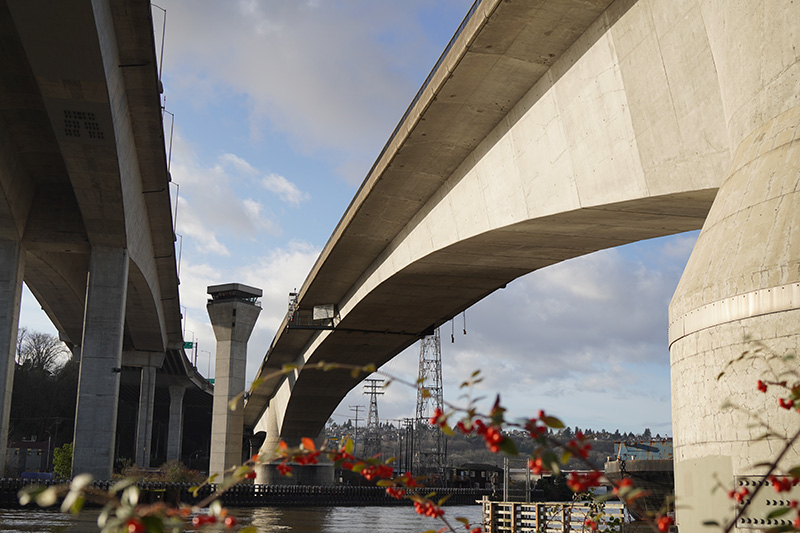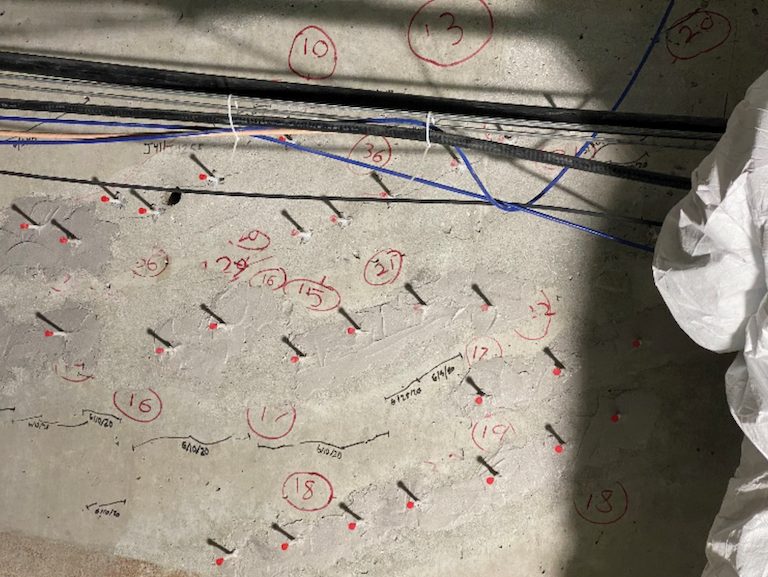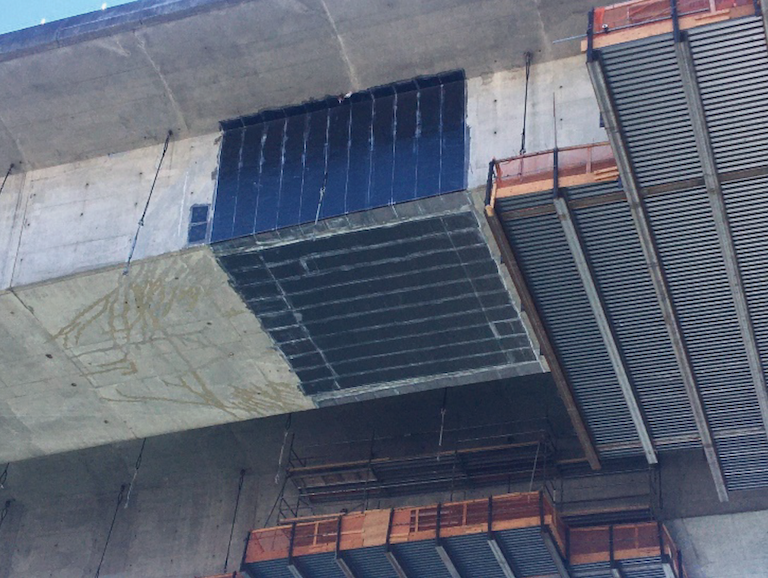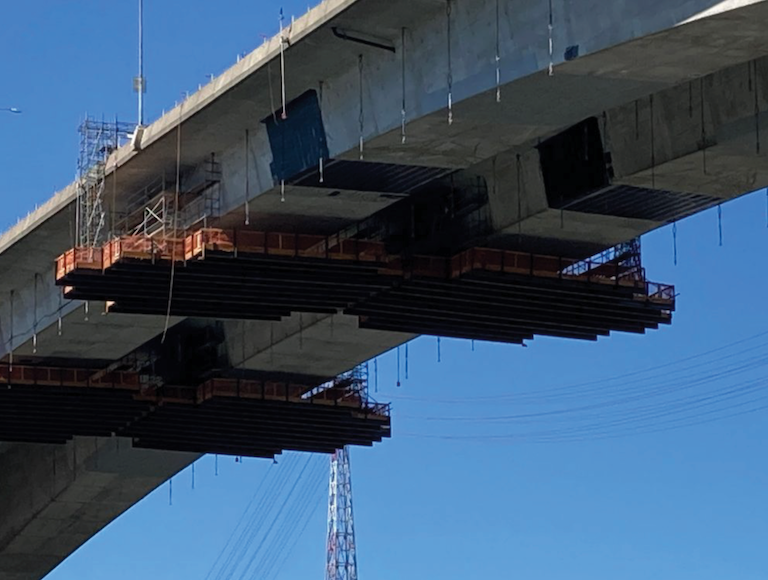For nearly 40 years, the West Seattle Bridge has been a primary route connecting West Seattle to the greater Seattle metropolitan area. The bridge spans 1,300 feet and is comprised of three cantilevered segmental box-girder concrete sections that rise to a maximum height of 140 feet over the Duwamish Waterway. In March 2020, the bridge was abruptly shut down to all traffic, disrupting the lives of those traveling to and from West Seattle for what would turn out to be nearly 2.5 years. The shutdown occurred because routine inspections had identifi ed accelerated growth of cracks at a significant enough level that immediate stabilization was needed, followed by either long-term repairs or replacement of the bridge. In 2013, inspections revealed cracks forming in the webs and slabs of the bridge’s two main girders. A series of more frequent inspections was performed, which included some epoxy crack injection installation of crack monitoring technology. Between 2013 and 2019, increases in crack growth continued to cause concern. A new engineering analysis was performed, confirming exponential crack growth, which prompted SDOT to close the bridge to traffic in March 2020.
After an extensive evaluation and planning period, a dedicated project team was formed to handle the emergency repair project for the bridge. A two-phase approach to stabilization and long-term repair was developed. Phase 1 focused on the stabilization to mitigate any concerns regarding potential collapse. Phase 2 would involve either replacement of the bridge or comprehensive long-term repairs and upgrades necessary to restore and extend the life of the existing bridge. Phase 1 of the bridge repairs, which began in late 2020, required the use of a customized access system consisting of scaffolding and working platforms, which streamlined work taking place underneath the structure hundreds of feet in the air. The phase 1 repair plan was essential to stabilize the structure, while a determination could be made about the future of the bridge structure. The scope of the phase 1 repairs was extensive and included three parts. First, epoxy injection of the cracks was necessary, which consists of filling the cracks with epoxy resin to restore structural integrity and prevent further damage.
Next, external post-tensioning was installed within the concrete girders. Post-tensioning is a technique for reinforcing concrete, enhancing its performance under both normal and adverse conditions. And third, carbon fi ber reinforced polymer (CFRP) was installed on the concrete at select locations along the superstructure to provide additional reinforcement. CFRP is a composite material known for its high strength-to-weight ratio, making it ideal for strengthening structures and enhancing their durability. These comprehensive measures were undertaken to ensure structural stability of the bridge while planning ensued for Phase 2.
While the initial stabilization project (phase 1) was performed in 2020, comprehensive studies were completed to determine whether the best path forward was long-term repairs or replacement of the bridge. Based upon the studies completed, the owner, Seattle Department of Transportation, chose a phase 2 path of long-term repairs, which began in late 2021.

Innovative Construction Techniques
Based on their extensive experience, as well as their completion of Phase 1 repair activities, PULLMAN was selected as a subcontractor for the Phase 2 construction and working in conjunction with STRUCTURAL TECHNOLOGIES and Simpson Strong-Tie provided expertise for implementation of:
• Epoxy crack injection
• CFRP (Carbon Fiber-Reinforced Polymer) wrapping
• Quality control

One of the first issues that needed to be addressed was the significant cracking that had taken place over time, which was made worse by increased traffic combined with the effects of seawater that had seeped into the cracks and corroded the embedded reinforcement. Epoxy crack injection is a highly effective method for filling and sealing cracks in concrete. Specifically formulated epoxy is injected into the cracks under pressure, ensuring a strong bond with the surrounding concrete and a watertight seal. Contractors worked closely with engineers to locate and document all cracks in six areas on the two bridge girders that had been identifi ed as high risk. This process was scrutinized closely in the early stages of the project, including the validating penetration of the materials through core sampling. This invasive testing became less frequent as the project progressed and confi dence in the process was established. By the completion of the project, over 15,000 linear feet of crack injection repairs had been made, equating to nearly three miles. This process not only extended the life of the bridge but enhanced its overall strength and stability, while -other repair scopes were being completed. CFRP, or carbon fi ber- reinforced polymer, technology is an innovative technique that played a vital role in the success of the project. CFRP is a lightweight, high-strength composite material that off ers exceptional corrosion resistance, making it an ideal choice for strengthening concrete structures in demanding environments. Both interior and exterior CFRP strengthening was installed on the existing spans, increasing the concrete’s capacity to meet the demand from the design loads. In some cases, it was necessary to anchor the CFRP. To do this, Ground-Penetrating Radar (GPR), non-destructive testing equipment was first used to locate the embedded reinforcement within the concrete to ensure no rebar would be damaged while drilling holes into the concrete. A piece of carbon fi ber was inserted into the hole and then splayed out onto the fabric already installed. A thin layer of epoxy was applied over the CFRP to ensure a strong, durable bond to the concrete. The combination of the CFRP and anchors allows the CFRP to reach a much higher strain under loading conditions having a greater impact on the concrete’s load-carrying capacity. There was a set of strict quality control guidelines associated with the CFRP installation process as well, including documentation of information such as surface preparation details, temperatures, and dew points. Proper quality control procedures for CFRP applications also include recording all lot numbers of materials utilized – epoxy, carbon fi ber and all coatings used in the process. Finally, verifi cation of the appropriate bond to substrate and tensile strength of the materials are important to ensure design requirements are met. The bond is tested using ASTM D4541 to demonstrate that the CFRP is adhered to the substrate at 200-psi or greater, which was required for this project. The tensile strengthis verified using ASTM D3039 testing. The CFRP used in the fi eld is sampled each shift, and the 12ʺ °¡ 12ʺ sample panels are sent out for tensile testing at an approved laboratory.

Unique Jobsite Challenges
Construction projects on or around bridges bring their own set of challenges, ranging from access to traffic control. The West Seattle Bridge also has unique challenges specifically related to its height. The bridge runs high atop a series of other roadways, bridges, waterways and alongside power transmission towers. The majority of the repairs completed were at 100-feet or more above the ground. Scaffolding was erected around the existing structure, and suspended platforms were put in place as a base of operation. There were areas where the erected and installed access could not reach along the underside of the bridge. For these areas, the team needed to utilize an Under-bridge Inspection Truck (UBIT). The UBIT is an articulating bucket at the end of an arm anchored to the platform, providing access to hard to-reach areas. For all those working at height, whether on scaffolding or in the UBIT, proper training was provided, and safety harness protocols were in place throughout the project.

Environmental Challenges
Seattle is known for its damp and rainy weather conditions, and this created special challenges for the project team. The frequent rain and winds posed two types of challenges, including safety and operational. Safety of the workforce is the top priority, so when strong winds or other inclement weather that could be harmful occurs, job sites are shut down causing delays. The rain also causes a major operational concern when CFRP is being installed, as it could impact surface conditions, and a clean, dry surface is required.
Special tents were erected around work areas to ensure that the environment remained dry. The areas under construction remained dry. Heaters and dehumidifiers were used to ensure the temperature and humidity remained consistent. Any significant fluctuation in these conditions could prevent the CFRP and epoxy from curing properly, and therefore compromise the integrity of the strengthening techniques.

In addition, working over an active waterway made it necessary to guard against materials and debris falling into the water. All necessary procedures were put in place to avoid these issues. One of the most unique aspects of the project was having to work around the activities of the Spokane Swing Bridge directly underneath. This bridge remained open during construction, serving as the main thoroughfare between West Seattle and nearby neighborhoods. However, the bridge would periodically need to open to allow boat traffic to pass through. The two spans would each rotate 45 degrees on a turntable rather than raising into the air like a drawbridge. Construction crew kept in contact with bridge personnel and generally had about 10 minutes’ warning each time the bridge was going to open. During this time, they would have to move box girders and any other materials that might be in the way, all from the floating platform hundreds of feet in the air. Overall, the unique aspects and tight timeline to complete the repairs made for a fast-paced project, enhancing the importance of safety training and performance.

Results
On September 15, 2022, after nine months of the phase 2 construction project, the West Seattle Bridge officially passed its final safety test. The last two suspended platforms were removed, and the bridge was reopened to public traffic on September 17th. Throughout the repair process, rigorous safety procedures and quality control measures were in place to ensure that the work was completed safely and met the highest performance standards. With the impact on the community the bridge closing caused, and the importance of re-opening, the use of CFRP to strengthen the West Seattle Bridge demonstrates the effectiveness of innovation and technology in addressing infrastructure challenges.■
